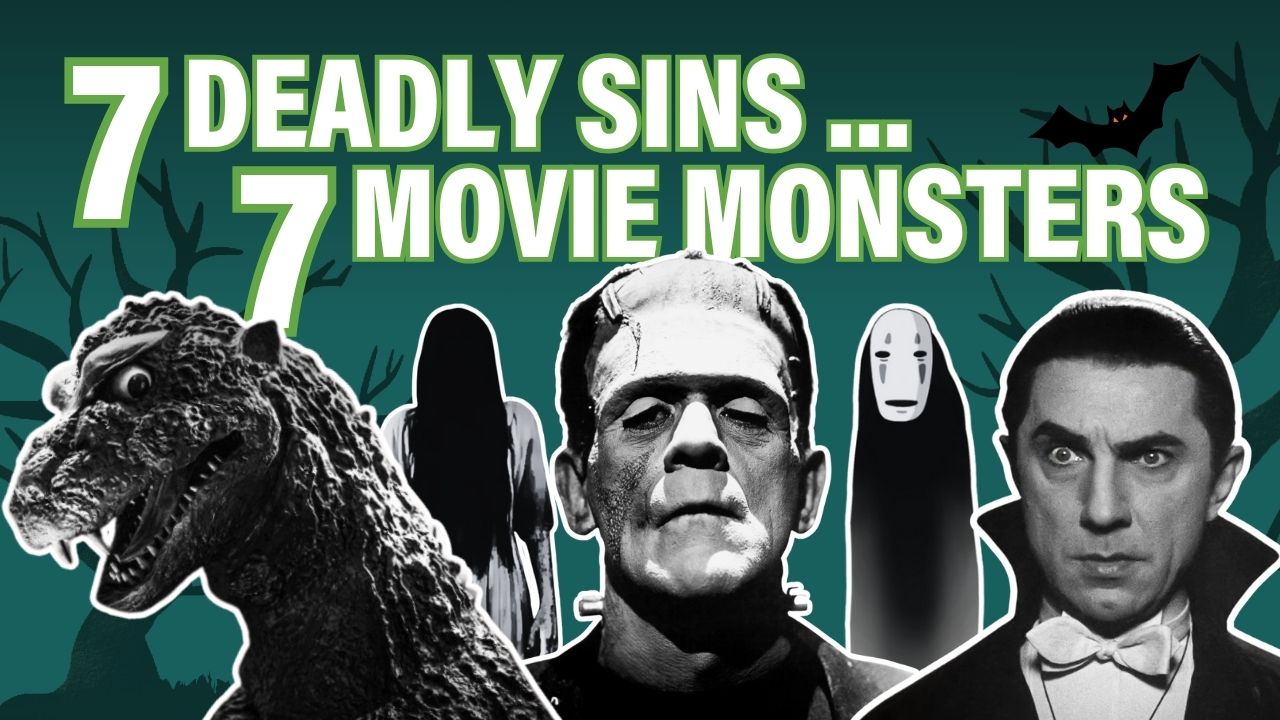The Apostle Paul tells us that the “wages of sin is death” (Romans 6:23). And rarely do we see that dynamic play out quite as dramatically as in a monster movie.
Most Christians avoid horror flicks: Indeed, some may run, screaming, as if they were in one. That reaction is perfectly understandable and, very often, absolutely justified. Still, many a scary movie comes with moral or even spiritual underpinnings. Characters may be snared by their own sins. Monsters might be manifestations of humanity’s twisted desires. And while not every horror film has a happy ending, some do land in a space where the monsters are vanquished, and the night vanishes in the light of a new day.
So with that in mind, I thought we’d take a look at Christendom’s ancient list of the Seven Deadly Sins and see just how some famous movie monsters might reflect them, punish them or simply teach us about them.
Bob Hoose, Kennedy Unthank and I talk a little bit about these famous monsters and what makes them synonymous with certain sins on our YouTube channel, which you can watch below. But if you’d like to go the old-school route, read on. And, of course, we won’t stop you from doing both—as you’ll find a few interesting twists between the two.
Envy: Count Dracula, Dracula (1931)
Let’s be honest: Everyone’s favorite Transylvanian bloodsucker could slot in for almost any of the deadly sins. The character’s sexual undertones might make him a good pick for lust. His voracious appetite for human blood feels pretty gluttonous. And the fact that he literally sleeps all day? That’s pretty slothful, all right.
But the vampire, as embodied by Bela Lugosi in 1931’s Dracula, might’ve been driven more by envy than anything. He envies John Harker for his beautiful fiancée, Mina. From his castle in Transylvania, Dracula jealously eyes London for all its teeming life and bountiful prey. (His home hunting grounds have become rather … drained.) But most of all—after a few lifetimes’ worth of immortality—he envies mortality. “To die, to be really dead, that must be glorious!” Dracula says, adding that there are “far worse things awaiting man than death.”
We do not know how this particular version of Dracula came to be. But in many versions, Bram Stoker’s famous character became a monster because of his desire for power and immortality. And it’s telling, perhaps, that in the 1931 version that Dracula offers his assistant, Renfield, the same promises of power. (It takes an envier to know an envier, perhaps.)
The fact that Dracula is undead seems ever-so-fitting for the sin of envy, too. After all, envy leaves us bereft of the joy God meant for us. When we’re always longing for what other people have, we lose sight of God’s own gifts to us. And it can leave us feeling rather dead.
The Hobbit (both J.R.R. Tolkien’s original book and Peter Jackson’s needlessly long trilogy) is essentially all about recovering some lost property: Thirteen dwarves and one rather meek hobbit set out to reclaim a treasure stolen by a dragon. What can the dragon Smaug actually do with his ill-gotten gains? Absolutely nothing. He can’t spend a single gold coin on a single candy bar (which, if we’re honest, would melt before he could eat it anyway). It can’t be that comfortable to sit on. And he doesn’t even have an Amazon account. Nope, all the treasure he’s stolen is, ironically, completely worthless.
But that’s the thing about the worst form of greed: We want stuff not because we need it, or because it could do someone else some good, but just to have it. And that desire for more feels not just like an addiction in The Desolation of Smaug, but a disease—one contracted by the hoard’s once-and-future owner, Thorin Oakenshield.
The Bible warns us against all forms of greed, of course. “But those who desire to be rich fall into temptation, into a snare, into many senseless and harmful desires that plunge people into ruin and destruction,” reads 1 Timothy 6:9. That ruin lands on Smaug and Thorin alike.
This sin had some strong monstery contenders. The Blob from the 1958 movie of the same name devours anything in its path. The Sarlacc from 1983’s Return of the Jedi functions like a living garbage disposal. But both are simply following their instincts: It’s not a sin, just their nature. But No-Face give us a different, and more poignant, representation here. And his narrative better illustrates the nature of gluttony.
First, the shadowy creature shows up at a bathhouse, a silent and seemingly gentle visitor. He wears a mask (which reminds us that we often try to hide our own gluttonous desires). He’s a pleasant presence at first, and he pays handsomely for the food he’s given. But he doesn’t stop eating. And—after facing rejection from Sen, the movie’s main character—he begins to gobble up the folks who come near him. (There are those who believe that No-Face was corrupted by the bathhouse itself, a place of lavish and perhaps unseemly luxury.)
But when Sen gives him a magical, bitter dumpling to chomp on, No-Face … well, quickly and disgustingly sheds most of what he’s eaten. It’s a reminder that reining in our own appetites can be painful. And to keep our own gluttonous desires at bay requires self-discipline. But when No-Face’s narrative journey ends, he’s back to his old self and absolutely content to sip a bit o’ tea.
Lust: Imhotep, The Mummy (1932)
Unlike Dracula, the mummy Imhotep never asked to be immortal. In fact, immortality was thrust upon him, thanks to some pretty serious indiscretions with an Egyptian princess. In the original film, Imhotep (Boris Karloff) and Anck-su-namun (Zita Johann) were lovers, and the affair was so scandalous that, when it was discovered, the princess killed herself (or so the movie implies). Alas, Imhotep’s desire for his paramour was so strong that he decided to try to resurrect Anck-su-namun via blasphemous means. When that indiscretion was discovered, he was promptly buried alive and cursed for good measure. And when a magical scroll resurrects Imhotep, he immediately starts pursuing a woman who looks like Anck-su-namun—with the intent to kill, mummify and resurrect her.
Whew! That’s a lot of narrative unpacking, but important nevertheless, as some versions of The Mummy suggest a multi-life love story. But love is about mutual attraction, devotion and commitment. Lust is all about unhealthy desire and self-gratification. The 1932 version of Imhotep fits both of those to a well-wrapped T.
Pride: Frankenstein’s Monster, Frankenstein (1931)
Give the good doctor his due: He cannot be faulted for lack of ambition. Henry Frankenstein (Colin Clive) wanted nothing less than to become like God and create new life. And he was … um, successful? His creation (another monster role for Boris Karloff) can grunt and stagger, and he has some very strong feelings about fire. But when the monster first moves, Frankenstein is ecstatic. “Now I know what it feels to be God!” he says.
The classic 1931 Frankenstein definitely has a Tower of Babel vibe going for it, and the whole film is essentially a cautionary tale to stay in your lane. But Frankenstein’s pride wouldn’t accept such limitations—much to the horror of the Bavarian village he lived in. “Pride goes before destruction, and a haughty spirit before a fall,” reads Proverbs 16:18.
The moral of the story: Don’t play God and try to create new life. (AI developers, are you listening?)
Sloth: Samara, The Ring (2002)
It’s not easy to find a monster that’s somehow related to sloth. After all, lazy monsters would make for a very boring movie. And while plenty of horrific villains and killers prey on the lackadaisical and unwary, you don’t find whole movies predicated on lag-about victims. So let’s turn our attention to The Ring (based on an earlier Japanese film, Ringu).
The premise is simple: A haunted VHS tape is making the rounds. Anyone who watches said tape will die within seven days—courtesy of the movie’s very creepy little-girl ghost, Samara. It’s a pretty poor excuse to kill someone. In your typical horror flick, victims tend to “earn” their early demise through sin or stumbles or even just by being jerks. But here, your only sin is … sitting down to watch a little TV?
That definitely doesn’t count as sloth in my estimation—if it did, my Sundays during football season would be very sinful indeed. But Samara does prey on passive viewers who could’ve and should’ve been doing something more productive with their time. Plus, it helps drive home a point we often make at Plugged In: Be careful what you watch. You never know what might be lurking there.
Wrath: Godzilla, Godzilla (1954)
Tokyo would’ve never felt the wrath of Godzilla if it hadn’t been for that nuclear test. But when that blast wakes the monster up, there’s no going back. Godzilla—160 feet tall in the original movie—is out to make humanity pay for his lost beauty sleep.
Godzilla comes with a neat bit of Seven Sins symmetry. After all, the bomb itself is a weapon of wrath. The 1954 film was released just nine years after the atomic blasts at Hiroshima and Nagasaki, and the horrors of nuclear holocaust were in the forefront of the makers’ minds. “The theme of the film, from the beginning, was the terror of the bomb,” Producer Tomoyuki Tanaka said. “Mankind had created the bomb, and now nature was going to take revenge on mankind.”
Interesting word, revenge. Wrath is, by its nature, cyclical. You hit, I hit back harder. And while the Bible certainly holds a place for righteous anger, it encourages us to set aside pointless fury. “For God has not destined us for wrath, but to obtain salvation through our Lord Jesus Christ,” we read in 1 Thessalonians 5:9.
Sounds wise to me.
















